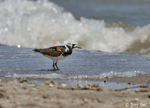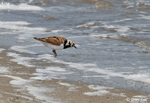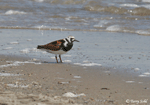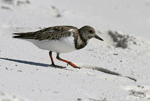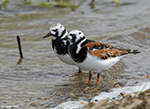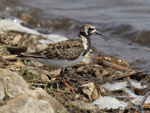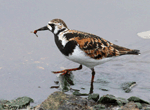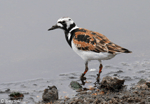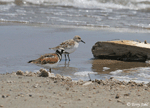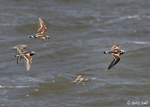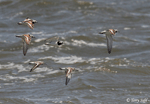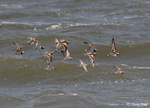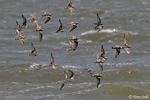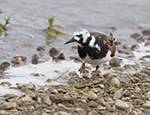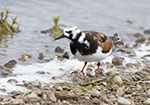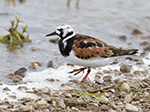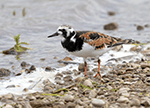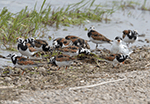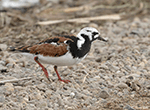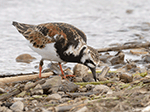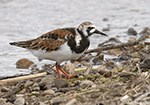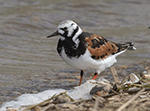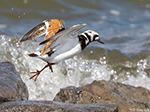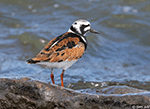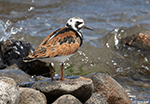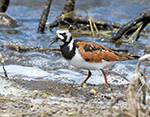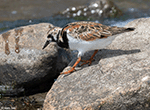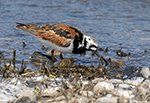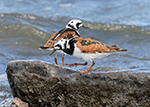Ruddy Turnstone
Arenaria interpres
| Length: 9 to 10 inches | Wingspan: 17 to 18 inches | Seasonality: Migrant |
| ID Keys: Strong breeding plumage with black and white face, black breast, and white underparts. Short orange legs and short dark pointed bill. | ||
 The Ruddy Turnstone can be
found along the coastlines of six continents during the winter, but nest solely
in the high Arctic tundra. They are scarce inland during migration except
around the Great Lakes. In South Dakota, they are found as relatively rare
migrants, particularly during spring migration. They are named after their habit
of turning over stones, shells, and pieces of wood with their beaks as they
search for food, with several birds sometimes cooperating to overturn heavier
items.
The Ruddy Turnstone can be
found along the coastlines of six continents during the winter, but nest solely
in the high Arctic tundra. They are scarce inland during migration except
around the Great Lakes. In South Dakota, they are found as relatively rare
migrants, particularly during spring migration. They are named after their habit
of turning over stones, shells, and pieces of wood with their beaks as they
search for food, with several birds sometimes cooperating to overturn heavier
items.
Habitat:
Breeds on the high Arctic Tundra. In migration and in winter, mostly found along rocky shorelines or beaches covered with seaweed and debris.
Diet:
Primarily feeds on insects during the summer breeding season, as well as berries, seeds, and moss. During migration and in winter, will also feed on crustaceans, mollusks, small fish, marine worms, bird eggs, and carrion.
Nesting / Breeding:
Non-breeder in South Dakota. On their nesting grounds in the Arctic, the nest is a shallow scrape, with both males and females making shallow scrapes but with the female ultimately selecting the final nesting location. It may be placed in an area of peat, thin vegetation, or a sandy or muddy location, often in a high spots such as a small hummock or ridge. Any nest construction other than the scrape is sparse, but it is sometimes lined with a few leaves or other bits of vegetation. The female lays between 2 and 4 eggs, with both parents incubating them. The young hatch after 3 weeks, and leave the nest almost immediately. The young feed themselves, typically following the male, but both parents offer protection. The female leaves the family first, followed by the male, with the young becoming completely independent and free of protection about 3 weeks after hatching.
Song:
Vocalizations include a sharp low rattling, sharp short alarm calls, and other chattering calls.
- Click here to hear the rattling song of a male Ruddy Turnstone, recorded in 2001 in Finland1
- Click here to hear the sharp calls of a Ruddy Turnstone, recorded in Great Britain2
- Click here to hear the flight calls of a lone Ruddy Turnstone, recorded in coastal Florida3
Migration:
Summers throughout the high Arctic. Winters along all U.S. coastlines, as well as the coastlines of every continent except Antarctica.
Interactive eBird Map:
Click here to access an interactive eBird map of Ruddy Turnstone sightings
Similar Species:
Generally distinctive if seen well, particularly with the bolder plumage on breeding season birds. In South Dakota, unlikely to be confused with other shorebird species, but elsewhere could potentially be confused with the following
- Black Turnstone - They share the same structure and general appearance, but Black Turnstones are primarily dark brownish-black in plumage, with a white belly, and lack the warm brownish colors on the back of a Ruddy Turnstone. Black Turnstones also lack the bold facial pattern of a Ruddy Turnstone.
- Surfbird - Surfbirds are found along the west coast of North America, where they could cross paths with a Ruddy Turnstone. They share the same general size and structure, but plumage patterns are obviously different, particularly when compared to the bold rusty, black, and white patterns of a breeding plumaged Ruddy Turnstone. Surfbirds are plainer in color on their upperparts, and have some markings on their underside (compared to the clean white of a Ruddy Turnstone). Surfbirds also have yellow legs compared to orange legs for a Ruddy Turnstone.
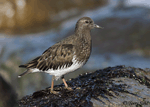 |
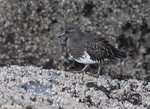 |
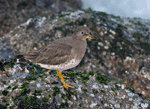 |
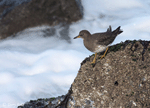 |
| Black Turnstone | Black Turnstone | Surfbird | Surfbird |
Conservation Status:
Generally common and widespread, with healthy populations in parts of a very broad global distribution. Recent trends show numbers likely increasing in North America, while decreasing in parts of their Eurasian range. Overall, the IUCN currently considers the Ruddy Turnstone to be a species of "least concern".
South Dakota "Hotspot":
In migration they are said to be found along either rocky or sandy beaches, but with rocky beaches something of a rarity in South Dakota (!), I've had the most luck locating them on some of the few, large, sandy beach areas available in the state. The northern edge of Lake Thompson has an extensive sandy beach, and despite their relative rarity as migrants in South Dakota, I have encountered them a number of times there.
Further Information:
Photo Information:
May 26th, 2014 - Weisensee Slough in western Minnehaha County, South Dakota - Terry Sohl
Additional Photos:
Click on the image chips or text links below for additional, higher-resolution Ruddy Turnstone photos.
Audio File Credits:
- 1Lauri Hallikainene, XC234454. Accessible at www.xeno-canto.org/234454.
- 2David Darrell-Lambert, XC447140. Accessible at www.xeno-canto.org/447140.
- 3Paul Marvin, XC460719. Accessible at www.xeno-canto.org/460719
| Click on the map below for a higher-resolution view |
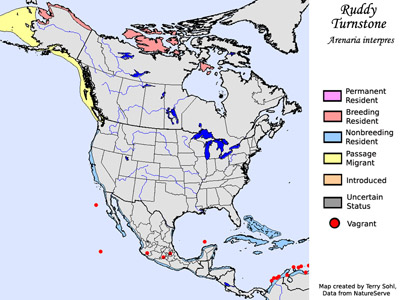 |
| South Dakota Status: Rare migrant throughout the state. More common in the northeast, and less common in western South Dakota. |
Additional Ruddy Turnstone Photos
Click for a higher-resolution version of these photos

